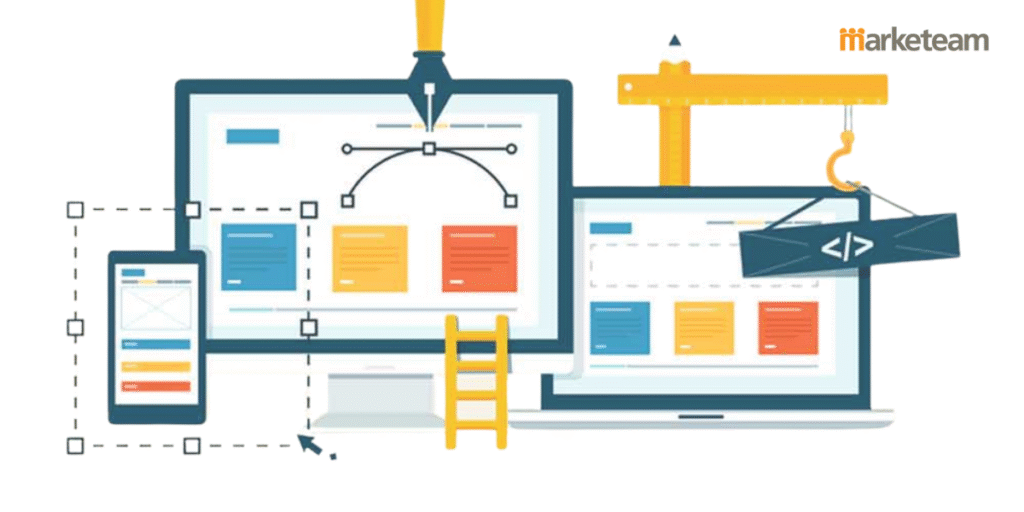How to Plan a Website Redesign Without Losing Customers
Worried your website redesign will tank your traffic and scare off existing customers? You’re not alone in that fear. Most small businesses put off updating their website because they’re terrified of losing the customers they’ve worked so hard to attract.
This guide walks you through planning a website redesign that protects your current conversions while fixing what’s not working. You’ll learn how to map your customer journey, set clear goals, and test changes before they go live.
Small businesses across Brisbane have used these strategies with Marketeam to refresh their sites without losing hard-won customer trust. If you want those same results without the risk, keep reading.
Start by Mapping Your Customer’s Journey
Before making any changes, you need to understand how customers move through your existing site. Tools like Google Analytics, combined with customer journey mapping, help you see exactly where visitors engage or drop off.

Let’s have a look at this customer journey map, and let it become your roadmap for protecting what works during the website redesign process.
- Track Every Step from Landing to Conversion
Most small businesses guess at their customer journey instead of actually tracking it. You might be wondering how to actually do this without getting lost in data. The good news is you can start simple with the tools you already have.
Pull up your analytics tools and look at which pages customers visit before they buy, enquire, or contact you. For example, a tradie might find that customers land on a blog post about pricing, then check the services page, and finally submit a contact form. That’s three key customer touchpoints in their buyer journey.
Note where customers spend the most time and which pages lead to actual business results. If your “About Us” page gets tons of traffic but zero conversions, that tells you something important about your current site.
- Identify the Pages That Actually Drive Sales
Your homepage might get the most traffic, but it’s rarely the page that closes the deal (and yes, we’ve all obsessed over homepage design while ignoring the pages that actually pay the bills).
Look beyond homepage vanity metrics and find pages that generate enquiries, phone calls, or purchases. These are your money pages in the customer lifecycle.
Some pages might look outdated, but convert brilliantly because the content speaks directly to customer pain points. Maybe your 2019 case study page still brings in leads because it answers the exact questions your target audience asks. That’s valuable insight you can’t afford to lose during a website refresh.
- Spot the Drop-Off Points Costing You Money
Every website has pages where potential customers lose interest and leave without buying. In our website development projects, we regularly see businesses losing customers at predictable spots.
Now that you know where people go, look at where they’re leaving. Check your analytics for pages with high bounce rates or where visitors abandon the buying process. These drop-off points reveal exactly what’s broken in your customer’s experience.
Common problem areas include confusing navigation, slow-loading pages, or forms that ask for too much customer data upfront. Fixing these trouble spots should be your priority, as they’re already costing you potential customers right now.
Once you understand where people abandon their journey, you can redesign those pain points first.
Know What You’re Trying to Achieve
Too many redesigns start with “we need it to look modern” and end up as expensive mistakes. Let’s be honest here, most businesses redesign because they’re bored with their current look, not because they’ve identified real business needs (trust us, we’ve seen that ‘let’s just make it look modern’ disaster play out more times than we can count).
From our experience building websites for Brisbane SMBs, we recommend starting with specific goals first. What do you actually want to achieve? We suggest setting clear targets like increasing enquiries by 25% or cutting checkout abandonment in half.
These business goals give your redesign project real direction instead of just guessing.
Redesigning just because competitors have shiny new websites rarely fixes your actual problems or helps your customers. Instead, focus on what’s broken right now.
Maybe your conversion rates are low, mobile users struggle to navigate, or your buying process confuses people. Those are real issues worth solving during a website redesign process.
Your Buyer Persona Drives Every Design Choice
The fastest way to lose customers is by designing for what you like instead of what they need. Your website redesign should match how your target audience actually thinks and shops, not your personal taste.

Think about it this way. Your design choices need to fit how real customers research and make buying decisions online. A tradie looking for quick quotes wants different things than a CEO researching year-long software solutions.
The tradie needs pricing upfront and a simple contact form. Meanwhile, the CEO wants case studies, detailed service offerings, and proof that you understand their business needs.
Same website redesign process, completely different customer journeys.
So how do you know what your buyer persona actually wants? Talk to your existing customers about their website experience before you change anything. Customer interviews and customer data will guide better design decisions than guessing what works.
Ask them what frustrated them, what helped them decide to buy, and what nearly made them leave. These valuable insights from real buyer personas beat assumptions every time.
Protect What’s Already Working
Once you know your goals, the next step is protecting the parts of your site that already convert. And that’s where things get interesting, because most businesses focus on what they want to change instead of what they need to keep.
Research from Forrester shows that well-designed websites can have conversion rates over 400% higher than poorly designed ones (one wrong move here and your conversion rate drops 40% overnight; we’ve seen it happen). Before you change anything, identify which elements currently drive conversions.
Here’s what to keep versus what you can change:
| Keep | Consider Changing |
| High-converting call-to-action buttons | Outdated design elements |
| Customer testimonials that drive sign-ups | Confusing navigation menus |
| Key pages with strong engagement | Slow-loading images |
| Forms that customers actually complete | Poor mobile responsiveness |
Your best-performing customer touchpoints should stay in similar positions with similar messaging. This maintains customer familiarity and keeps conversion rates stable during your website refresh.
Our suggestion? Test major changes on small sections first rather than launching a completely new site overnight. This staged approach protects your existing customers while you improve their experience.
So start with one key page, monitor website performance, then roll out changes gradually based on user feedback and site performance data.
Test Before You Go Live for Providing the Best Customer Experience
What if your new design confuses customers instead of helping them? But wait, there’s more to it than just clicking through pages yourself. Real user testing catches problems you’ll never spot on your own.
We recommend running your new design past existing customers or a small test group before the official launch. Get their honest feedback on the customer’s experience. Watch where they get stuck, what confuses them, and whether they can complete the same tasks they could before.
Next, check that all customer touchpoints work properly across the entire buyer journey. Contact forms need to be submitted correctly, phone numbers should click to call on mobile, and maps must load without errors. Remember, one broken element in the buying process can kill your conversion rates instantly.
Finally, test the complete customer journey on mobile and desktop because one broken step loses sales fast. We always use Google’s mobile-friendly test to check mobile responsiveness. Remember that most potential customers now browse on phones, so your website’s functionality needs to work flawlessly on smaller screens.
Expert’s Reminder: Poor mobile performance means losing customers before they even reach your service offerings.
Ready to Redesign Without the Risk?
The beauty of a well-planned redesign is that you can spot problems before they cost you customers. At Marketeam, we specialise in website redesigns for small to medium businesses, and we know how to protect your conversions while improving your customers’ experience.
After launch, keep a close eye on these key areas:
- Monitor conversion rates, form submissions, and bounce rates for the first two weeks
- Set up feedback channels so customers can report confusing elements right away
- Track website performance against your business goals
- Watch for changes in user engagement and sign-ups
Professional website developers handle redesigns strategically by mapping customer journeys, protecting high-performing elements, and testing thoroughly before launch.
This approach keeps your existing customers happy while attracting new customers through better site performance. So, let the right redesign strategy turn your website into a stronger sales tool without disrupting the customer relationships you’ve already built.
FAQs
How long should a website redesign take for a small business?
Most small business website redesigns take 4-6 weeks with proper planning. The redesign process includes mapping your customer journey, creating designs, testing, and launching. Rushing it risks losing customers, while dragging it out delays improvements.
Will I lose my Google rankings during a redesign?
Not if you handle it correctly. Maintain your URLs, set up proper redirects, and keep your content. Search engine rankings stay stable when you preserve your site structure and avoid breaking links that customers and Google rely on.
Should I redesign my entire site at once or in stages?
Staged redesigns reduce risk for businesses that rely heavily on their website. Start with key pages, monitor performance, then expand. This redesign strategy protects your customers while you improve their experience section by section.
also read: Elevating Business Operations with Janson Construction’s Renovation Services

